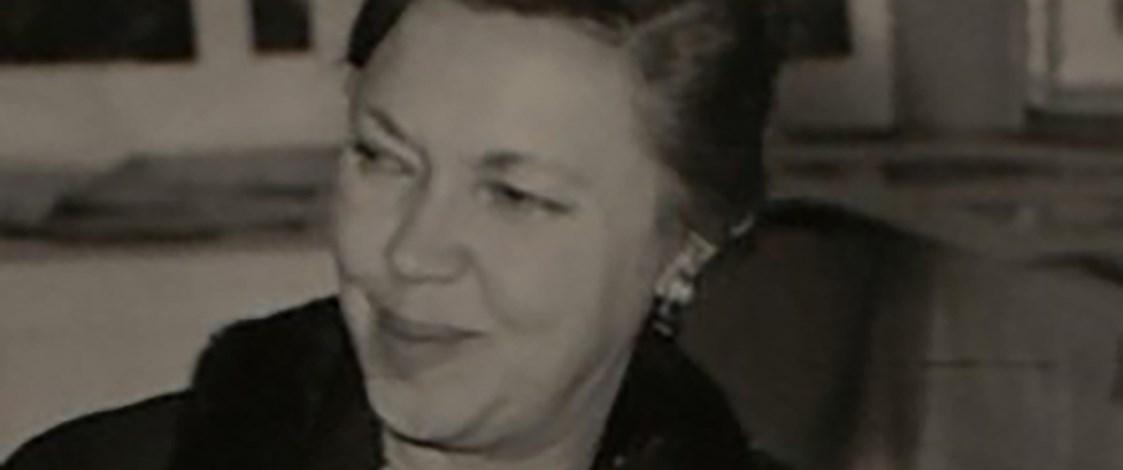Stories
June Black
1910-2009

June Black was an artist with a lifelong appreciation of clothes. She kept a record of her thoughts and ideas in journals."Why do I love handbags so much?" she asks herself in a journal entry. "Because they go everywhere with you like a friend who seems to pay for everything."
Born in Auckland in 1910 June Black emigrated to the United States of America with her parents Lesley Lionel Berry and Hermia (nee Holmes) when she was just six months old. By 1927 the marriage had broken down and Hermia and her two daughters, June and Faith, returned to Auckland from Philadelphia.
In 1931, June married Robert Frankston Black, a young engineer and moved to Christchurch where June gave birth to their first child, who tragically succumbed to a cot death. This loss marked the start of a lifelong battle with depression.
In 1939 Robert was promoted to District Mechanical Engineer which required relocation to Wellington where they lived on Mt Victoria overlooking Evans Bay. It was here that June gave birth to a second child in 1940, a daughter, Virginia Sue and her youngest, Sheridan in 1942. For the time being June’s energies were taken up fulfilling the roles of wife and mother. Despite the austerity measures of the war years with its financial restrains, June still managed to indulge in and prioritise her passion for fashion and beautiful objects. She mail-ordered a Persian lamb coat from America and continued to collect and create various garments finding expression for her creativity through the wonderful clothes she made for herself and for her two girls.
June had briefly attended Auckland University’s Elam Art School at the age of 16 when she returned from America but in was not until 1952, in her early 40s and living in Wellington, that she once more began to pursue her artistic interests taking pottery classes with Helen Mason at the Petone Polytechnic and reading widely.
Among others she explored the ideas of Jean Baudrillard, Joseph Beuys, Eugène Ionesco, Martin Heidegger, Soren Kierkegaard, Samuel Beckett, Franz Kafka and Gertrude Stein and developed a leaning towards existentialism, Dadaism, Surrealism and theatre of the absurd. At this time too she acquired a small electric kiln and it was working with the size limitations of this that led to her unique and innovative creation of her ‘longbods’ and the unleashing of her imagination in clay, paint and language.
June had several solo exhibitions showcasing her ceramics and paintings at the Architectural Centre Gallery in Wellington, followed by other exhibitions at Christchurch’s Gallery 91 and New Vision gallery in Auckland. Her reputation as an innovative, eccentric and charismatic ceramicist resulted in the inclusion of her work in various national and international shows, in Washington and Australia.
Her particular interest in fashion, clothing and fine fabrics was evident in her first solo exhibition in 1958, The Search for the Fabulous Idea. She curated and installed her show with carefully considered labels that identified the paintings and ceramics in the show in terms of costumes; 'Costume to Protect and Embolden', 'Costume to Simulate Audacity', 'Mask to be Worn in the Face of Indifference'. Also included were titles of innovative equipment that the members of the expedition would use; a Machine to Plot the Blind Drift of Habit and Routine, the Abyss Tester, and Contrivance to Keep out Unwelcome Thoughts to be worn on the head.
Her second show in 1959, The Intellectual Fashion Show, mimicked the idea of the Parisian haute couture fashion house as a metaphor to investigate the ways in which people clothe themselves with various identities, ideologies and agendas. This exhibition elaborated on her ideas of costume that she had started to explore in The Search for the Fabulous Idea but this time proposes other costumes and introduces a new 'cast' of characters. June produced an eccentric catalogue to accompany the exhibition and instead of listing the details of each work, she wrote a short play around their titles. She called it Dialogue and Catalogue and it served as an instruction manual explaining in a narrative form, how the exhibition should be approached. The viewer coming to the show inadvertently plays the part of the customer to the fashion house, being presented with various garments none of which eventually appeal. These costumes, of no particular substance, are created conceptually as literary tropes. They express the fantasies available for people to escape from, and armour themselves against the rigours of daily life, social hypocrisy and cultural expectation.
Costumes can meet our desire to be dressed and addressed, to see and be seen.
In these exhibitions and scattered throughout her journals are many unillustrated references to costumes. To 'understand' June Black’s costumes the audience must accept the invitation to contribute to their creation by bringing their own insecurities, perceptions and imagination to them and so the same costume will 'look' and be different to different people.
The Intellectual Fashion Show 2016 was based on the collected costumes of June Black, collated from her writings by her daughter Sheridan Keith. Contemporary artists and creative practitioners were invited to create them.
June Black died in 2009, aged 99.
Text by Janie van Woerden. Banner image © Sheridan Keith.